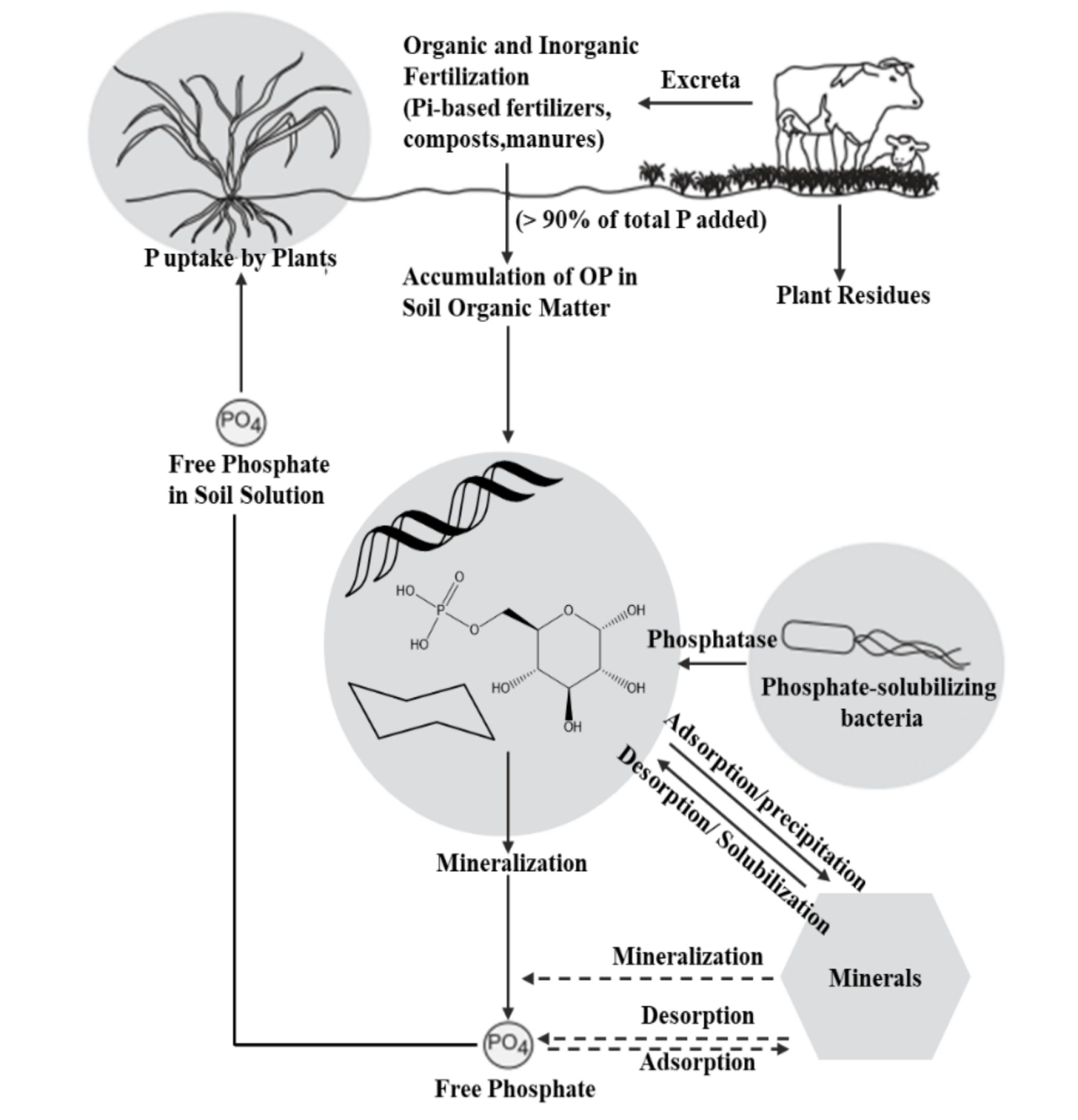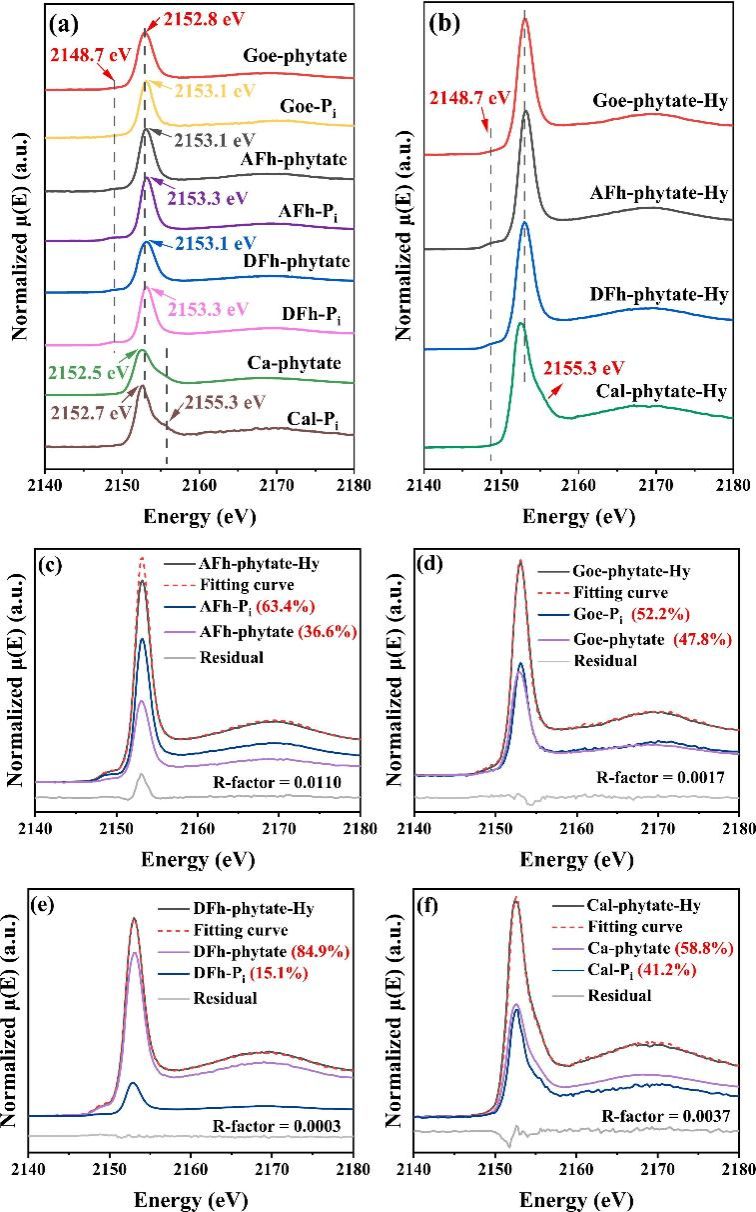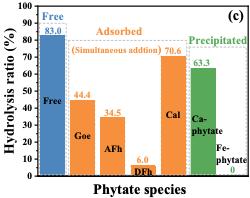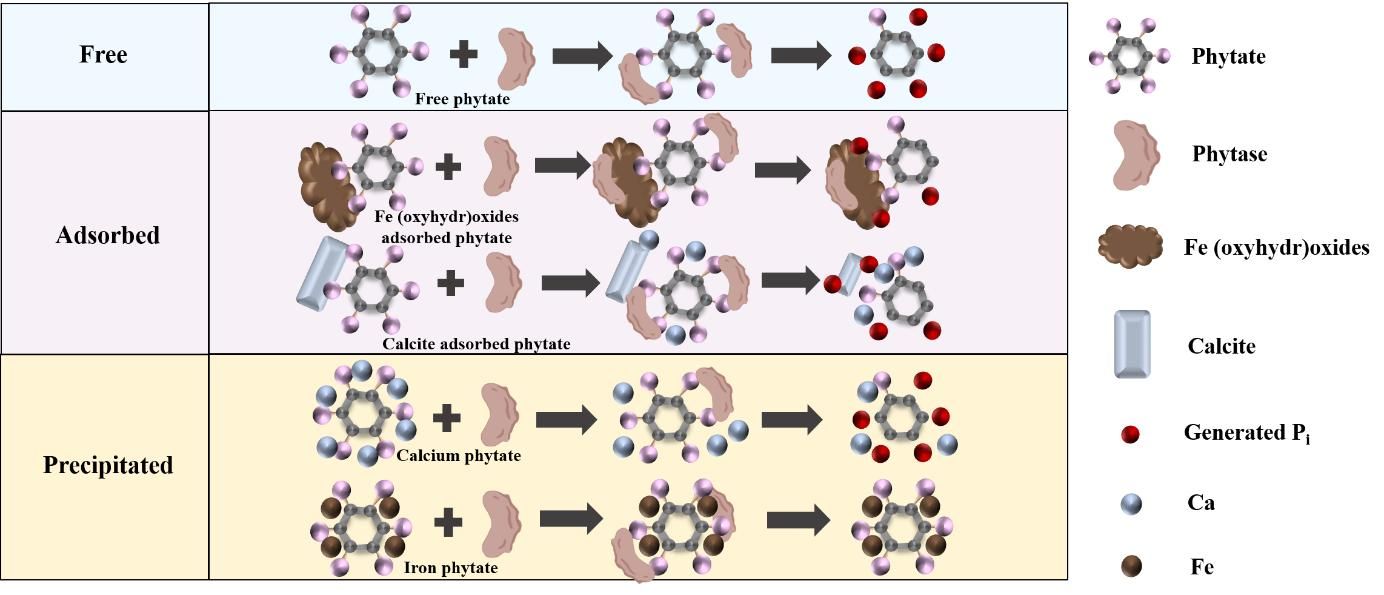南湖新闻网讯(通讯员 赵万通)近日,我校资源与环境学院土壤矿物与环境团队在土壤有机磷转化与高效利用方面取得重要进展,相关成果分别以“Biogeochemical Processes and Efficient Utilization of Soil Organic Phosphorus”与“Phytase-mediated hydrolysis of different soil phytate species: Kinetics and mineral interfacial mechanisms”为题,发表于Springer Nature出版的专著和自然指数期刊Geochimica et Cosmochimica Acta。
有机磷是土壤中重要的磷库,其生物地球化学过程是土壤磷循环的核心环节,对维持植物生长和土壤养分平衡具有关键意义。研究团队对土壤有机磷的来源与形态、吸附–解吸和矿化过程、主要影响因素、前沿分析技术及调控措施进行了系统梳理。结果表明,动植物残体、微生物活动和人为输入是土壤有机磷的主要来源,其生物有效性在很大程度上受制于矿物表面的吸附与解吸作用。土壤矿物以及由微生物和植物根系分泌的磷酸酶能够促进有机磷矿化,释放无机磷酸盐,进而提高磷的有效性。研究还指出,土壤pH、吸附机制、磷酸酶活性、阳离子与有机质的协同作用以及微生物互作是影响有机磷矿化的关键因素。文章同时总结了有机磷研究常用的先进分析方法,并从农田管理角度提出提升有机磷利用效率的调控策略,展望了未来在复杂环境条件下深入揭示有机磷转化机理的研究方向与挑战。
植酸是土壤中最常见且较稳定的有机磷物种,其矿化过程直接关系到土壤磷的有效性。团队在弱酸性条件下,通过批量实验和光谱分析,对不同形态植酸(游离态、吸附态、沉淀态)的酶促水解动力学和矿物界面作用机制进行了系统研究。结果显示,游离态植酸最容易被酶解,其中6个磷酸基团中有5个能够被快速裂解;沉淀态植酸的水解取决于其稳定性,植酸钙相对容易水解,而植酸铁几乎完全不发生水解。在铁氧化物体系中,植酸的水解程度与矿物的吸附能力呈负相关:溶液中的游离态植酸优先被水解,其次是矿物表面部分裸露的磷酸基团。与“酶–植酸同时加入”体系相比,植酸或酶的预吸附均会显著抑制水解,其中水铁矿的抑制作用强于针铁矿。相比之下,方解石和植酸钙体系在酸性条件下表现出更高的初始水解速率,这与钙基矿物的不稳定性密切相关,其释放的Ca²⁺和游离态植酸有助于增强酶活性和底物可利用性。该研究不仅揭示了植酸矿化的动力学特征与界面机制,也为提升酸性土壤中磷的有效性提供了新的理论依据和实践启示。

图1. 土壤有机磷循环示意图

图2. 标样和产物的磷 K 边 XANES 光谱表征和定量拟合分析




图3. 不同植酸形态的酶解效率与机制差异
我校资源与环境学院的硕士毕业生刘哲和张磊为论文第一作者,王小明副教授为论文通讯作者。华中农业大学冯雄汉教授、谭文峰教授、黄巧云教授、万彪教授、研究生赵万通、张万年也参与了研究。本研究得到国家自然科学基金和国家重点研发计划的资助(41977021、42030709、2023YFD1702800)。
审核人:王小明
【英文摘要1】
Organic phosphorus (OP) serves as a significant soil phosphorus (P) pool, with its biogeochemical processes being essential components of soil P cycle. These processes are critical for maintaining plant growth and dynamic balance of soil P. This paper comprehensively reviews the biogeochemical processes and efficient utilization of OP, encompassing the sources and forms of soil OP, the adsorption-desorption and mineralization processes of OP, key influencing factor, relevant advanced analytic techniques, and regulation measures of OP. The soil OP primarily originates from plant and animal residues, microbial activity, and anthropogenic inputs, and its bioavailability are remarkably influenced by the adsorption and desorption processes on soil minerals. In addition, soil minerals and phosphatases, secreted by microorganism and plant roots, catalyze the mineralization of OP compounds, leading to the release of phosphate and thus increasing P bioavailability. The key factors influencing OP mineralization include soil pH, adsorption conformation, phosphatase activity, the coexistence of cation and organic matter, and microbial interactions. Furthermore, we provide an overview of advanced analytical techniques commonly used in soil OP research and propose strategies to enhance the bioavailability of soil OP from a farm management perspective. Finally, we outline potential future research directions and challenges aimed at further elucidating the biogeochemical processes of OP under complex environmental conditions.
链接1:https://link.springer.com/chapter/10.1007/978-3-031-91114-9_21
【英文摘要2】
Phytate mineralization, influenced by mineral interfaces and the binding forms of phytate (including free, adsorbed, and precipitated species), plays a crucial role in the phosphorus (P) biogeochemical cycle in soils. However, quantitative comparisons of enzymatic hydrolysis across different phytate species, and the interfacial mechanisms occurring on mineral surfaces that influence these processes, remain poorly understood. This study investigated the kinetics and mechanisms of phytase-mediated hydrolysis of phytate in the presence of soil minerals (calcite, goethite, and ferrihydrite) at pH 5.5, comparing hydrolysis of free phytate and precipitated phytate using macroscopic batch experiments and spectroscopic analysis. The hydrolysis ratio of free phytate reached ~83 % within 48 h, with five out of six phosphate groups cleaved. In contrast, the hydrolysis of precipitated phytate was influenced by the stability of the precipitate, with calcium phytate being more readily hydrolyzed than iron phytate. In the presence of Fe (oxyhydr)oxides, phytate hydrolysis was negatively correlated with adsorption capacity: free phytate in solution was preferentially hydrolyzed, followed by the hydrolysis of partially exposed phosphate groups on surface-adsorbed phytate. Compared to the simultaneous addition system, phytate pre-adsorption on aggregated ferrihydrite inhibited hydrolysis by 36.2 % at 12 h, whereas the inhibitory effect was less pronounced for goethite (9.6 % inhibition at 48 h), likely due to the rapid equilibrium adsorption of phytate regardless of the adding sequence. In contrast, pre-adsorption of phytase on minerals decreased its catalytic activity, thereby inhibiting phytate hydrolysis. Compared to Fe (oxyhydr)oxides systems, both calcite and calcium phytate systems exhibited higher initial hydrolysis rates, attributed to the instability of Ca-bearing minerals under acidic conditions. This instability released Ca2+ and free phytate, enhancing phytase activity and phytate availability. These findings provide new insights into organic P mineralization processes and offer practical implications for improving P availability in acidic soils.
链接2:https://doi.org/10.1016/j.gca.2025.06.030